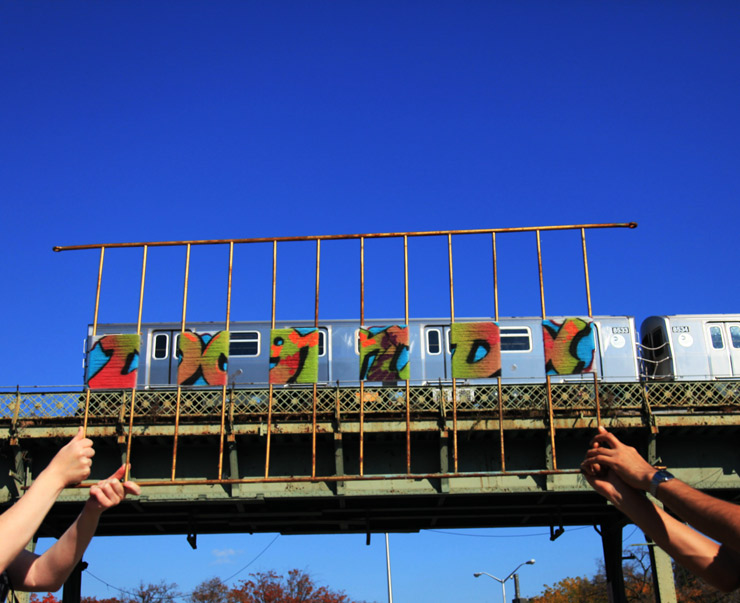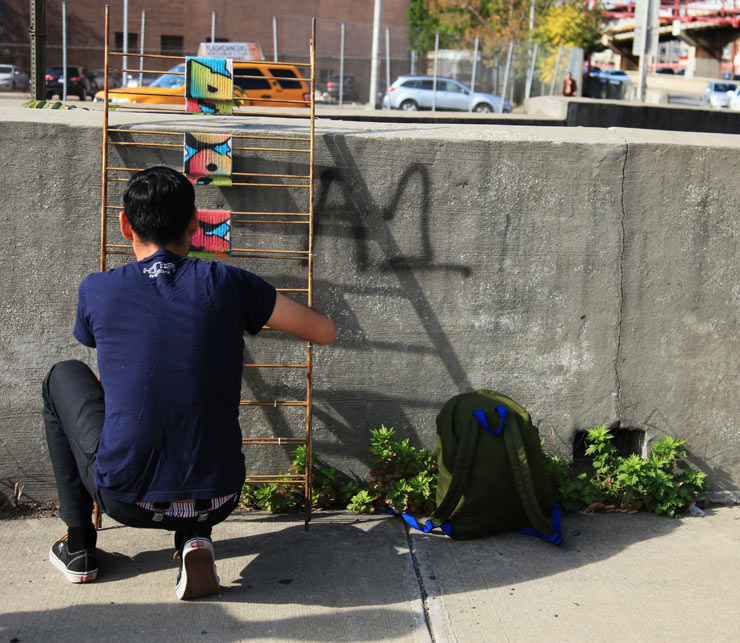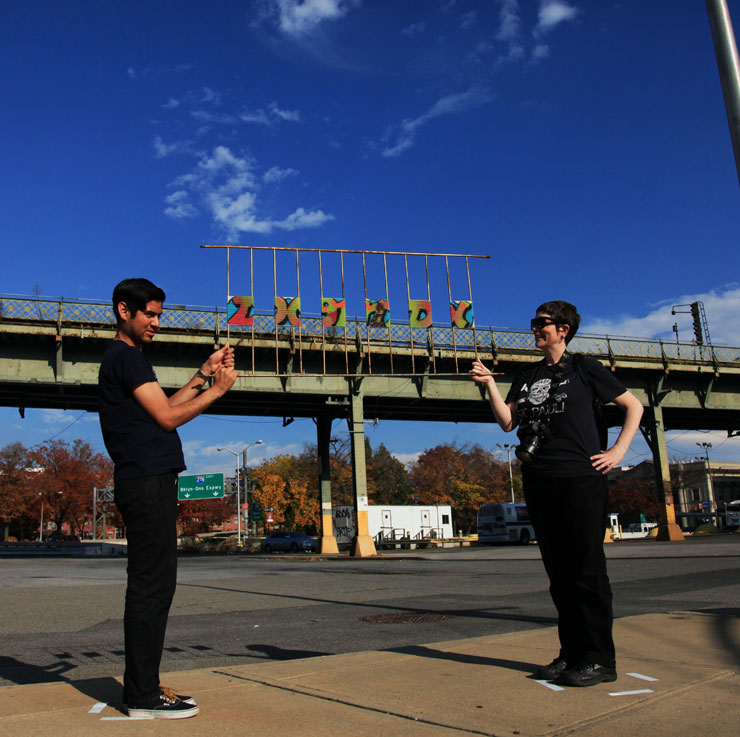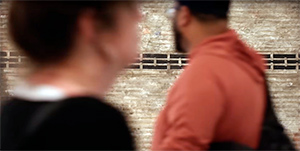Conceptual Piece Lifts a Toast to “The Style Master General”
“Every time a subway passes through the station, it is as if Dondi’s work is back on the trains,” Hot Tea says as he describes his new work of yarn. The renowned New York graffiti artist was immortalized straddling between two trains in a photo by Martha Cooper while painting outside the law and inside the train yards during the late 1970s and early 80s. Today Dondi White is still looked to as a pacesetter and open-minded innovator for new generations even 15 years after his passing.
“Dondi was lovingly referred to as ‘The Style Master General,’ as it was commonly accepted that he was the artist who set the standards for graffiti art in his time,” said noted graffiti artist ZEPHYR in his eulogy of his close friend in 1998. “He crafted letters that were both acrobatic and aerodynamic in nature and committed them to metal with remarkable precision.”
Hot Tea Pays Tribute to Dondi (photo © Jaime Rojo)
Today style masters in Street Art endeavor to set standards as well, and one of them is the Minneapolis born Hot Tea, a former graffiti artist who stopped hitting walls and is now an installation artist who defines dimensions and planes and calls attention to use of space with yarn. Closer to Fred Sandback than Dondi perhaps, Hot Tea departs from the formers’ minimalism but embraces the kaleidoscopic color choices of the latter. One of the Street Artists you need to watch, Hot Tea has impressed many quietly with his ingenious ability to redraw planes in our everyday existence using a simple medium in a non-destructive way – it is a sophisticated definition of working in context that creates a new context in the process. Handmade, personal, and often letter based, this is typography that typifies today’s D.I.Y. while nodding to the writers of New York’s storied streetstyle – it’s a narrative thread that travels decades backward and brings it to the present.
His new project isn’t even mounted on the street, but in his mind Hot Tea is bringing back one of his heroes by evoking his name and splashing his letters, and paying tribute here on the digital street. On a recent fall afternoon he used yarn, aerosol paint, and the side of a 1950s baby crib to put Dondi back on MTA trains at least for a minute. If you were there shooting you may have gotten a glimpse of what Henry Chalfant saw when catching one of his famous train photographs.
Hot Tea Pays Tribute to Dondi (photo © Jaime Rojo)
With two of today’s ardent graffiti/Street Art photographers, Luna Park and Jaime Rojo, in tow, the circle seemed complete as Hot Tea hoisted Dondi into the air and laid his tag onto trains passing overhead against a bright blue sky. As the conceptual piece travelled the afternoon from one Brooklyn elevated station to another, Hot Tea helped us imagine Dondi alive again on the J line into Bed Stuy. Now in that zone and seeing the hulking steel trains rumbling by, hearing their ear piercing screams as they roll the rusted curves of the tracks, the wonder of being in the yards may flash through your imagination. Hot Tea is there with you, seeing past the obvious to try and see much more.
Brooklyn Street Art: You were a graffiti writer for over a decade – can you tell people why Dondi White became such an important figure in the imagination of this generation?
Hot Tea: I think it has a lot to do with all of the iconic images of Dondi painting “Children of the Grave”. For those who weren’t part of the subway movement, those images gave it a kind of glamour. It seems a lot of graffiti writers imagined themselves in his shoes. I know I did. Painting whole cars on the NYC transit system was such a mystery until those photos came out and the light it shed was exciting and contagious. After subway trains became nearly impossible to paint all we could do was paint the streets. When that happened, it’s as if those photos and moments in the subway yard became even more special.
Hot Tea Pays Tribute to Dondi (photo © Jaime Rojo)
Brooklyn Street Art: When we speak with train writers from the 70s and 80s and the people who followed them, there is a nostalgia for that time because they lived it. When we talk to writers and Street Artists today, many of whom were born after those halcyon aerosol days, there is a nostalgia for what they imagine it must have been like to try to go ‘all-city’, to hit up train yards, to practice and develop in a city with a burgeoning hip-hop and punk scene. How would you describe your nostalgia for those times, if you have any.
Hot Tea: Being that I no longer practice writing graffiti, I do have a nostalgia of painting. When I first started out, I admired writers from all over. It was 1996 and the Internet was slowly coming to form so my main outlet for graffiti was magazines, books, and videos. My vision of NYC graffiti through viewing those sources was magical. I imagined the subway trains as I saw them in Subway Art, with graffiti on the outside and in. After realizing the NYC subway trains were now clean, it made me want to re-create that same energy and color on what was accessible to me – which were freight trains.
My main influences from the freight train movement were NACE, CRISPO, SIEN5, SLEJ, REFA & ASIA, DRONE, and lots of other west coast freight writers. Seeing all of those 90s freights rolling by allowed me to experience art like I have never before. The concept of rolling graffiti art and having it travel all nation was exciting. I can still remember painting our layup on a warm summer Sunday afternoon. My friends and I painting and enjoying each others company; I truly miss it.
Brooklyn Street Art: Can you describe this sense of camaraderie that artists on the street today have sometimes for the graffiti writers and early Street Artists who came before them?
Hot Tea: It’s interesting because there is an unwritten rule of ethics, mostly between graffiti writers about respecting the writers who have put in work before them. I think a lot of this stems from the nostalgia that was mentioned earlier. Many of us weren’t able to experience what it was like to paint in NYC during the 1970s and 80s. If there are any remaining artworks from that era that is all we have to remember, along with any documentation. Many of us try to preserve that history by going around it or not painting that wall or spot all together. As for street art… the thing is, graffiti started before the Internet. All we had were a few sources to go by on what was taking place on the subways and in the street.
Street Art started when the Internet was becoming a growing source, which means that it formed on a global scale. People from all over the world started doing street art influenced by many different things and not just hip hop and break dancing. In my opinion, I think this lead to a much different atmosphere in which street artists exist in. Since there were so many people doing it globally and for different reasons the camaraderie that we see with graffiti artists and writers that came before them doesn’t always exist in the street art world. Not to say that it doesn’t exist at all within street art, I just don’t think it’s as relevant as in the graffiti culture.
Hot Tea Pays Tribute to Dondi (photo © Jaime Rojo)
Brooklyn Street Art: This new project is really unusual – we’ve never seen something like it before – that a graffiti artist is lionized by a street artist using yarn, and in a conceptual way that is perhaps more performance than paint. Did the idea appear you while you were staring at trains, or maybe in a dream?
Hot Tea: I like to build upon what I have already done and this just felt like the natural step I had to take. I have worked with empty spaces and the architecture that exists within a given area before. Now I wanted to work with what was moving within a space. My initial thought for this concept was the New York City subway system. Being that I wasn’t able to experience graffiti on the subways, I wanted to re-create that with the medium I am using now, which is yarn. It was very exciting to finally have come up with a way to create that experience people had in the 80s of seeing whole DONDI cars roll into the station. Sometimes it does feel like a dream, but one that came true.
Brooklyn Street Art: Having documented and followed the birth and evolution of the current Street Art movement since the turn of the 2000s, we’ve always seen the intersection between the D.I.Y. practices of young artist neighborhoods and those on the street. In a way, yarn is a perfect tool for expression on the street today because it reflects the hand-made arts and ethos of back-to-basics in the arts – and the act of reaching back to a non-digital life. Do you think you were influenced by this D.I.Y. approach?
Hot Tea: Totally. I love what artists prior to me have accomplished all just by a few simple gestures with everyday materials. If you have a good idea and a lot of determination anything is possible.
Hot Tea and Luna Park during the project’s execution. (photo © Jaime Rojo)
Brooklyn Street Art: Does your work get grouped together with the work of Olek and Knitta Please and other who have used yarn on the street? Is it a fair or relevant comparison? Does it matter to you?
Hot Tea: It does. I am glad you asked this. What I am doing is NOT “yarn bombing”. The term yarn bombing is derived from the term graffiti bombing, meaning quick acts of painting or painting the streets illegally. “Yarn Bombers” do not face the same consequences graffiti writers face and I don’t think it is fair for people using yarn to share the term with people who are facing hard jail time. As far as being grouped with other artists who use yarn – that is something I would like to leave open for discussion. I just don’t agree with the term “yarn bombing”.
Brooklyn Street Art: You carry a photo of your grandmother with you wherever you go. Lee Quinones is known for tributes to his mom and has spoken about her influence when he painted New York trains in the 70s. What role does this family connection play in inspiring your work on the street?
Hot Tea: The reason I use yarn is because I didn’t want to end up in jail again. My family has seen me in there twice and both times were extremely painful. They have directly impacted my decision to switch from using spray paint to yarn and practicing non-destructive street art. I carry my grandmothers photo whereever I go because whenever we would visit her she would love to hear my stories about traveling. Now that she has passed away, she is with me where ever I travel experiencing it with me as I do.
Brooklyn Street Art: Did your grandmother make you hot tea on cold winter days?
Hot Tea: No she did not, but she did make me tamales on cold winter days. She was always so worried about me eating. Every time I would visit, the first thing she did was go to the kitchen and start cooking. She didn’t even ask, she just approached me with a large plate of mole, tamales and rice. I didn’t have much of a choice but to eat. I miss her.
BSA>><<<>>>><<<BSA>>><<<BSA>>>><<<BSA>>><<<BSA
Hot Tea: “Children Of The Grave”, Shot and Edited by Patrick Sullivan
“As an ex-graffiti writer of 12+ years there is no denying the influence of 80’s NYC subway graffiti had on me. I still remember the first time watching Style Wars and how much of an impact it had on me and my work. Dondi’s work stood out to me amongst them all. The way he spoke about his work, the colors and the style in which he wrote his letters were very inspiring. I no longer practice writing graffiti and have taken on yarn as my new medium of choice. I wanted to create a piece about one of my biggest influences non-destructively. The result was a performance piece with Dondi’s “Children of the Grave” series split up into small rectangles. Each rectangle was built up using individual strands of yarn in a grey color scheme to mimic the color of the subway. I then took Dondi’s iconic subway whole cars and created stencils of them. I broke up the stencil into sections and created what you see. Every time a subway passes through the station, it is as if Dondi’s work is back on the trains, just like they were back in the 80’s. Rest peacefully Donald. You are missed by so many. April 7, 1961 — October 2, 1998″ Hot Tea
<<>>><><<>BSA<<>>><<<>><><BSA<<>>><><<>BSA<<>>><<<>><><BSA Please note: All content including images and text are © BrooklynStreetArt.com, unless otherwise noted. We like sharing BSA content for non-commercial purposes as long as you credit the photographer(s) and BSA, include a link to the original article URL and do not remove the photographer’s name from the .jpg file. Otherwise, please refrain from re-posting. Thanks! <<>>><><<>BSA<<>>><<<>><><BSA<<>>><><<>BSA<<>>><<<>><><BSA
Other Articles You May Like from BSA:
Maybe it’s just us, but Milan-based Fra. Biancoshock appears to deliberately flummox and beguile with his public interventions and performances: messing with security cameras, staging public funerals ...
It’s good to see artists stretch themselves creatively, going outside of their comfort zone, hopefully, and discovering new techniques and approaches to their art. “You cannot stay at the same level ...
A fine artist who likes drawing and wood burning, TIKA also does her share of aerosol and stylized typography and characters across concrete bricks, along train tracks, and on the occasional van just ...
“Literally, the art had to leave the museum and come out into the street, as art in public spaces is the only art on display during these strange times,” says photographer Nika Kramer about this new ...
We’re back with more from La Cathedral, an abandoned factory in Barcelona that manufactures some mighty fine pieces woven by local aerosol hands, ready here for foreign import. Photographer and BSA c...
 BROOKLYN STREET ART LOVES YOU MORE EVERY DAY
BROOKLYN STREET ART LOVES YOU MORE EVERY DAY















